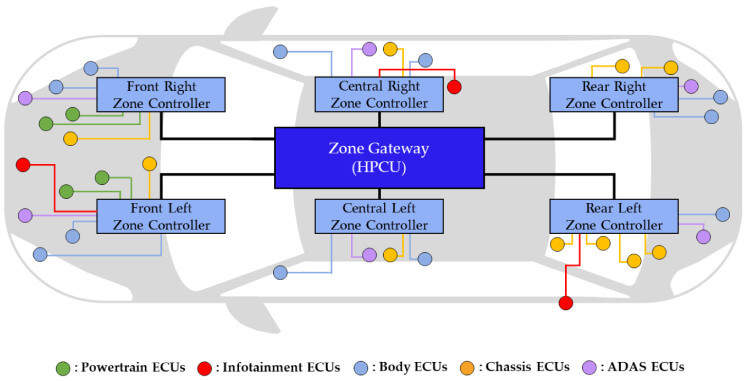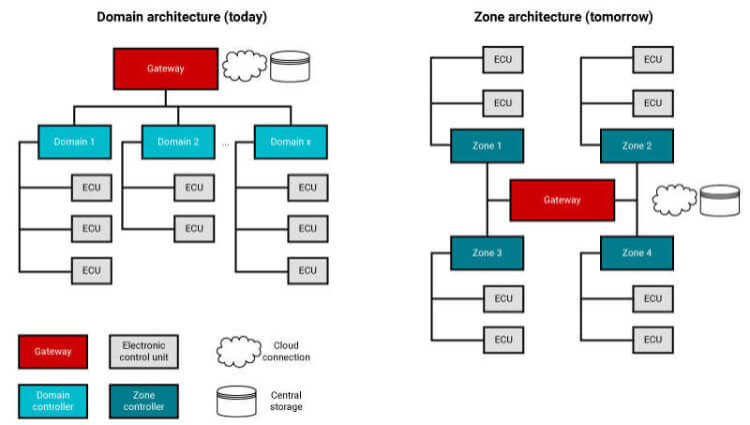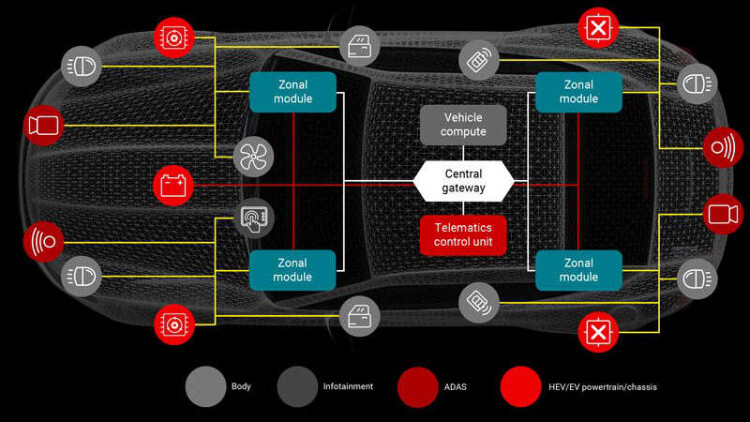Zonal Architecture: The Next Phase for Software-Defined Vehicles
Insights | 02-05-2025 | By Gary Elinoff

Automotive Zonal Architecture. Image source: MDPI
Key Takeaways:
- Software Defined vehicles depend on software updates rather than hardware replacement for affecting improvement or dealing with operational issues.
- SDVs, at present, depend on Domain-based Architecture, with Zone-based architecture embodying the next phase in vehicular evolution.
- Domain-based vehicles will be cheaper to manufacture, maintain and update.
Introduction
A software-defined vehicle (SDV) employs software to control and operate all vehicle functions, including but not limited to safety, security, steering and motor control, as well as infotainment. A key feature of SDVs is that they are wedded to the internet, with modifications, improvements and even necessary recalls (in many cases) being handled via online software updates.
Drivers won’t need to bring their vehicles to the dealer for updates and bug fixes, as these can be handled through online updates available via the internet. In a similar manner, you don’t need to bring your Windows PC to the dealer for updates and bug fixes either, which will give new meaning to the now-familiar maxim stating that a car is essentially a computer on wheels.
Another defining point for SDVs is that, unlike conventional vehicles, the actual hardware will be defined via open source. Vehicle manufacturers will have a choice of buying vehicle hardware components from any OEM that conforms to published specifications; the manufacturer is not wedded to one source, lowering costs thru competition. And, when changes for any reason need to be made, the changes are made via internet provided software downloads, not by swapping out hardware, saving time and money for customers, dealers and ultimately for manufacturers.
As you read this report, please note that the idea of an SDV is still evolving, and the terms are not really set in stone as yet. But, a good point of departure is the contrast between Domain-based vehicles and Zone based vehicles.
Domain vs Zone
As described by Texas Instruments[1], “Today’s E/E architectures primarily employ a domain architecture, organizing electronic control units (ECUs) and cabling together into specific domains such as the powertrain domain. In contrast, zone architectures group many – if not all – domain functions based on their geographical location, or zone, inside the car.”
The picture below compares the flow charts for the contrasting architectures: 
Diagram vs Zone Architectures. Image source: Texas Instruments
In the illustration above, the various vehicle functions, such as vehicle infotainment and advanced driver assistance systems (ADAS), may be segregated into different domains. Domain based system vehicles, just as Zone based vehicles, are designed to receive necessary software updates from the Gateway, which receives “fixes” over the internet. This is an enormous advantage to both customer and manufacturer, as trips to the dealer for in-house modifications are cut way down, saving time and money.
A more specific representation of Zonal Architecture is presented below:

Pictorial Presentation of Zonal Architectures. Image source: Texas Instruments
On examination of the four zones, each individual zone dominates its own geographical “turf”. There is no segregation by function, as is the case for Domain-based architecture.
The Evolution towards Domain Based Architectures
Over the decades, with automobiles employing ever more electrical and electronic functionality, the wiring was becoming more extensive, complex and troublesome. Domain architecture was conceived as an answer, and it was a good one. But it has become a victim of its own success.
As cars evolved, more and more electronic systems were added. The result, as described by Molex[2], is that “Vehicles with traditional or domain architectures are burdened with between 100 to 150 electronic control units (ECUs), each demanding its own dedicated wiring, contributing to an immensely complex and space-consuming cable harness system. Remarkably, as the rest of automotive systems have moved to automated or robotic assembly, these harnesses still require customization and hand assembly for each vehicle model.”
Furthermore, “Although domain architecture is an improvement over the traditional flat wiring systems, it represents only an intermediate step toward a fully modular, adaptable approach.”
Tesla Explores Zonal Architectures
One of the great problems with Domain based architectures is the sheer weight and space requirements imposed by copper cabling alone. It’s been estimated that zonal vehicles require three miles of wiring weighing in at up to 150 pounds!
Tesla’s Model 3, using zonal architecture, has reportedly cut the cabling length by half and the overall cabling harness weight by 80%. EV’s as a whole are navigating towards higher voltage electrical systems, typically 400V or 800V. And because Power = Voltage x Current, higher system voltage means lower current required, which means that thinner power cables will suffice, shedding still more weight.
Easier Manufacturing and Maintenance
Under Domain Architectures, each wiring harness must be mated to perhaps 100 or more ECUs and other endpoints. This a frustrating, labor intensive manufacturing task prone to maddening intermittencies. Worse still, given that cars must endure humidity, rain, mechanical shock and extreme temperature fluctuations, there is ample opportunity for disastrous failures in the field.
Under Zonal Architectures, there will be far fewer electrical connections, so less opportunity for difficulties. Due to eventual standardization of harnesses, there will be far fewer variations, and they will be used in a greater number of vehicles. Thus if failures do crop up, they will most likely appear over a range of vehicles, making it easier for reliability engineers to pinpoint the cause.
With Zonal Architectures, there will simply be fewer different wiring harnesses that will need to be designed. The cable and wiring manufacturers that build these assemblies will potentially sell a greater number of identical offerings.
This will allow manufacturers to concentrate their efforts on attaining greater reliability at lower costs.
On Windows, the F-35 and SDVs
Users of Windows PC will notice that Microsoft continuously uploads various “fixes” to improve the units’ function and resistance to malware and viruses. One needn’t bring their PC into the dealer, so in effect, it is very much like an SDV.
The company has stated that on October 14, 2025, these uploads will cease. Users will either have to upload Windows 11, or buy a new computer that sports the new operating system.
But maybe not. Strong rumors are afoot that on the payment of $30 to Microsoft, updates will continue for another calendar year. Talk about protection money - the Mafia would be proud!
This brings to mind the F-35.
The F-35 is very much like an SDV, and it, too, must be continuously updated from the plane’s US manufacturer. These updates will be available only through the sufferance of the US President. While there may not be a “kill switch”, the highly specialized warplane is not designed to be a dogfighter. Rather, it is the sword’s edge of a vast universe of software-based electronic functionality controlled exclusively by the US.
So, hundreds of millions of Windows users are dependent on “cooperating” with Microsoft. Will potential purchasers of the F-35 be willing to rely on the goodwill of the capricious US president and his ability to demand some sort of “protection money” whenever the mood strikes him?
Wrapping Up
Domain based architecture is now an established automotive technology, and it has a strong, logical base. It would seem to make a lot of sense for the each domain of an automobile, such as ADAS, Infotainment or the power train to each be controlled separately.
However, the problem is that some domains, such as the power train, will have their own subdomains located in every physical corner of the vehicle. The extensive length of the cable necessary to establish control will be that much more vulnerable to intermittencies and even disruption in the challenging environment. Switching to zonal architectures shorten cable lengths and ameliorate these issues, and in addition, fewer cables will be needed, lowering the overall weight of the vehicle.
Standardization will be a natural byproduct and not just for cabling. Fewer and smarter ECUs will make these devices ripe for the industry standards that are sure to evolve. Furthermore, these ECUs can contain protocols for the actuators that they are poised to control. And, as the functions of the ECUs, actuators and other components need to adapt to changes, they won’t necessarily need to be replaced, but rather they’ll be updated via updates downloaded from the web via the car’s Gateway.
Challenges and Opportunities
One of the greatest advantages of SDVs is that the exact same physical vehicles can be “software updated” to enable vastly different functionalities. For example, a “deluxe” version of a base car may sport an advanced driver-assistance system and a superior infotainment system. Manufacturers will be able to offer different models of the same car with little or no hardware divergence, like, dare I say it, the old Buick Electra 225 and the Cadillac.
The greatest challenge is to get more organizations on board with the idea of moving up from domain-based architecture to zonal architecture. The software interfaces from the internet gateways need to be conceptualized, as do the interfaces from the ECUs to the sensors and electromechanical actuators. Once the conceptualization has a running start, the standards competition will begin, with the biggest names on three continents vying for influence. It will not be unlike the process of adopting a new computer bus standard but on a far greater scale.
Once basic standards are established and made open source, manufacturers can build components, everything from the wire harnesses on down. Then, the game will have begun in earnest.
References
- Software-Defined Vehicles Shift the Future of Automotive Electronics Into Gear. Texas Instruments
- Zonal Architecture vs. Domain Architecture: Modular Automotive Infrastructure Face Off. Molex
Glossary of Terms
- ADAS (Advanced Driver-Assistance Systems). Systems designed to empower drivers with technologies to assist them in more safely controlling their vehicles.
- ECU (Electronic Control Unit). An onboard computer that controls one or more of the vehicle’s subsystems.

